Heat from a small fire
Appendix 1: Hollywood meets Alice Springs? Who has the last laugh? (1997), by Tony Dowmunt
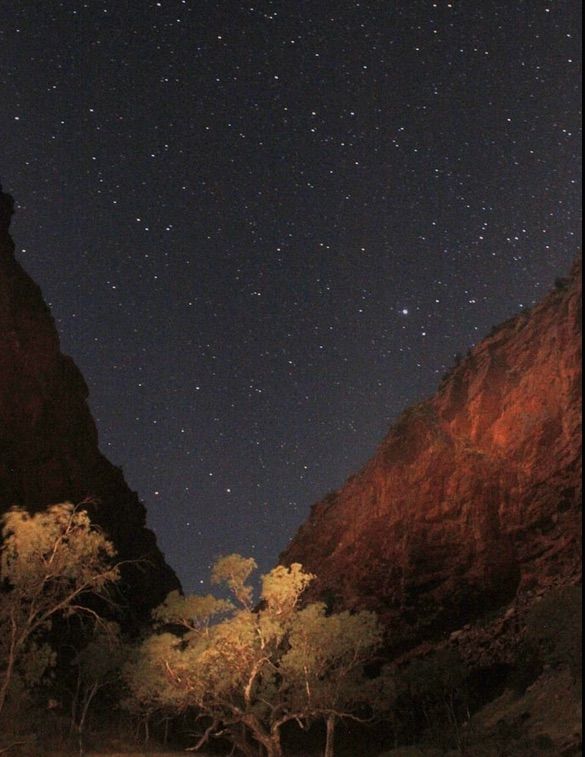
Simpson's Gap [Photo: Larapinta Creative Camps]
Hollywood meets Alice Springs? Who has the last laugh?
A dark night in the Central Australian desert, twenty miles outside Alice Springs. Normally the only visible light would be the carpet of stars in the clear black sky. But tonight at Simpson's Gap, a spectacular gorge in the Mcdonnell Ranges, the stars are thrown into shadow: the massive orange-red stone walls of the gorge blaze under movie arc lights. A feature film crew are setting up the next shot: there are three 35mm cameras and crews, at least as many assistant directors shouting through megaphones, and a group of wardrobe and make-up people hovering around the star, Olympia Dukakis.
I had been invited to visit the location because I happened to be staying in the same motel in Alice Springs as the film crew. The director was George Miller (not the Mad Max George Miller, everyone kept explaining, the other one): I bumped into him in the motel laundrette, and remember being surprised - and impressed - that a big movie director would do his own washing.
I was in Alice for a rather different purpose: making a documentary with an Aboriginal media group for Channel 4, about Aboriginal television and video. The visit to the feature film location was a fascinating glimpse of how the other half lived - particularly interesting as some of the Aboriginal people we had been working with on our programme had been hired as extras on the film.
For me the most important part of our project - and the most interesting sequences in the final programme we produced - involved the local TV stations (EVTV & Warlpiri Media) on the Pitjantjatjara and Warlpiri lands, hundreds of miles outside Alice, in the endless, apparently empty desert of the 'Red Centre'. Both these stations had started out as illegal, pirate operations to resist the influx of white TV via newly launched satellites (AUSSAT) in the mid 1980s. AUSSAT was the result of a strong lobby by Murdoch, Packer and other media barons and, at the beginning at least, conceived of its audience as being white - the scattered and isolated farming communities across the continent's interior - and ignored the needs of the extensive Aboriginal populations in the area. But even before AUSSAT was on air, the Pitjantjatjara and Warlpiri community operations had developed an easy-going style of local programming: they covered events in their area, like any other local station, but also started to use video in a process of 'cultural maintenance', recording stories (tjukurrpa), songs and ceremonies in the areas of country to which they referred.
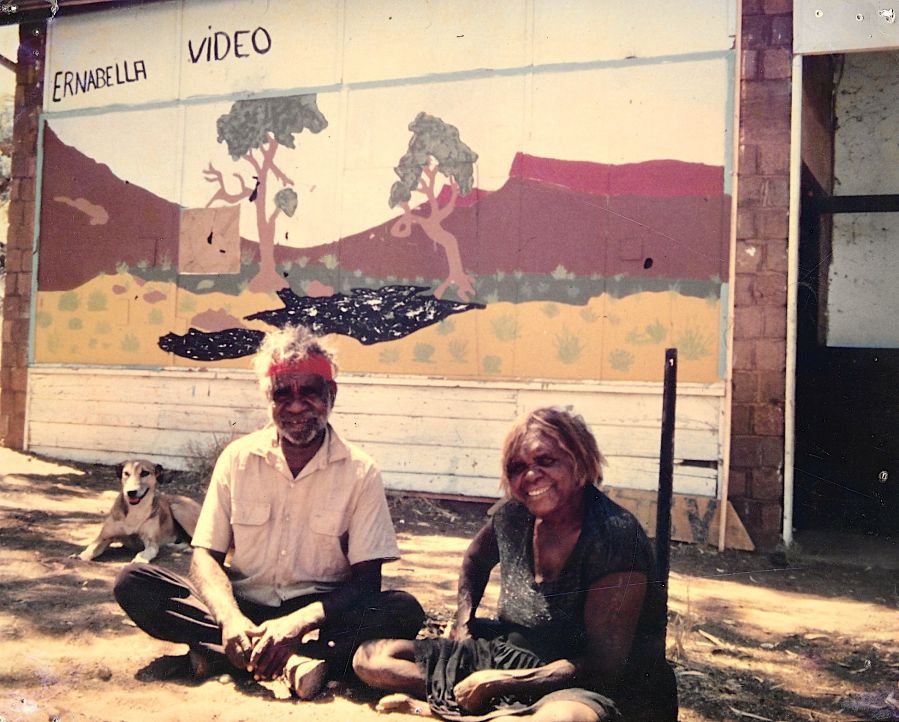
EVTV in Ernabella – Topsy Walter on the left.
The red desert isn't empty at all, of course: it's populated by what remain of the original inhabitants - scattered aboriginal communities, for whom the landscape teems with myth and meaning. For Topsy Walter, a member of the (Pitjantjatjara) EVTV board, Pitjantjatjara country is full of 'stories': EVTV's mission is to keep these stories 'strong'. For some Warlpiri elders who are now too old to travel from Yuendumu, the mission settlement, Francis Jupurrurla Kelly of Warlpiri Media goes on trips to record distant landscapes of which they are the owners or custodians; the playback sessions that follow back at Yuendumu are often very emotional affairs - people being re-introduced to country that they left, or were forced to abandon, fifty or sixty years ago.
EVTV and Warlpiri Media figured out how they could interrupt AUSSAT broadcasts as they began to be beamed in from the satellites, and how to substitute their own locally originated programming - live or from pre-recorded video cassette. In both communities this process was and still is under the control of committees of elders whose interest is in the maintenance of traditional culture. It provides stark contrast to the way in which TV is used as a mass medium in most other parts of the world, not only because of the degree of local control: the traditional restrictions on the circulation of sacred knowledge mean that much of what they shoot can't be shown even to the small but general audiences of their stations. EVTV have a cupboard in which they keep all the women's ceremonies recorded by Pantjiti Tjiyangu, their camerawoman: they can be viewed only by groups of women in the community who have had children.
EVTV invited us to film an expedition they were mounting to record on video a section of the Seven Sisters 'songline' at Kuruala - a remote site a couple of hundred miles drive across dirt tracks into Western Australia. On the way we picked up a convoy of old cars and a battered lorry full of people from the settlements we passed on the way. Some of these people were along for the ride, but most had ritual obligations in relation to the Seven Sisters recording: to be properly validated - a true record of the song, story or ceremony - these events have to be supervised by a range of people with particular kinship connections to the traditional 'owners' of the site, or custodians of the story. One of the custodians travelled with us in our Toyota on the last leg to Kuruala. He told us stories in Pitjantjatjara associated with the landscape we were passing: although I couldn't understand a word of what he was saying, it was fascinating watching his finger pointing at rocks and trees and tracing almost every contour of the land as he told us its story, its 'dreamtime' associations. When we arrived at Kuruala it was his job, as custodian, to narrate the story and direct the camera as it panned towards the women who were re-enacting the Seven Sisters as they fled from Nyiru, their tormenter.
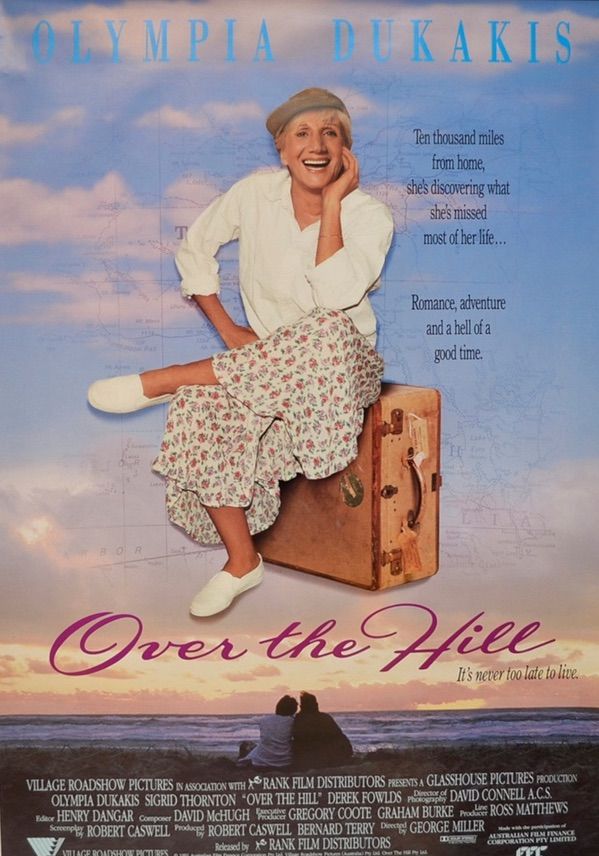
Over the Hill poster
It was members of this same group of women whom the Dukakis movie company had hired as extras - to perform a song in the background of the key scene of emotional revelation for Olympia's character. The film they are shooting – Over The Hill – is her story: an American woman, recently widowed, who goes to visit her daughter in Sydney. The daughter is married to a politician who is cynically exploiting ecological issues to win an election: they both reject Olympia, who - rather implausibly - 'goes bush': heads into the interior in her granddaughter's boyfriend's souped-up car. Through a series of encounters and adventures, she eventually 'finds herself as an independent woman, and at the end of the film magically regains her daughter's love and respect. Her emotional transformation is signalled in two key sequences: one in which she swims in the sea with a dolphin, the other where she is led at night by a wordless Aboriginal woman to a women's campfire and is sent into a trance by their chanting. The film plays on a romantic - not to say racist - assumption about the 'natural' healing power of Aboriginal culture, parallelling it to that old stalwart new age symbol, the dolphin. The woman leading her to the campfire was played by Pantjiti Tjiyangu, the EVTV camerawoman, and the women round the campfire were all from her community, a good few hundred miles south of Simpson's gap on the Pitjantjatjara lands.
The contrast between these two representations of Pitjantjatjara culture - at Kuruala, and here at Simpson's Gap - couldn't be more stark. For the Dukakis movie the women are stripped to the waist and painted up to perform the traditional songs - but they are miles away from their own country and from the sites where traditionally these songs should be performed. The scene being shot features these silent but 'deeply significant' encounters between Olympia and the Pitjantjatjara women, who somehow transmit their primitive power and arcane knowledge through their eyes alone: the performers do a great job, but admitted afterwards they thought the whole idea was absurd and comical - unsurprisingly, since it is so clearly based on Western myths about their culture. Most distorted and strange of all - to the Pitjantjatjara actors - was the director's insistence they build an enormous bonfire to sit around and sing traditional songs, because big flames would 'work best for the cameras'. In Aboriginal culture (as with most tribal peoples living in areas where wood is scarce) large fires are taboo: normally they use just two or three small logs to last the night.
But there's another side to the story. As the flames from the fire leap ten, fifteen feet in the air, and the First Assistant Director tries to organise the women for the first take, a Pitjantjatjara man wielding a camcorder circles the encampment, joking with the women and filming the moviemakers' antics.
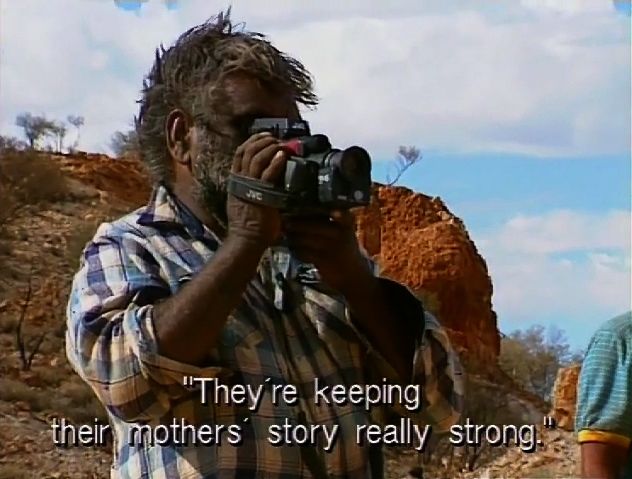
Simon Tjiyangu in Satellite Dreaming
This is Simon Tjiyangu, cameraperson with EVTV, and Pantjiti's husband. His jokes are about the spectacular waste of wood: the women joke back that they're grateful for it because they were getting cold waiting around half naked to be filmed. Simon videos these exchanges and the rest of the evening's shoot. When the movie work is done he returns to base with the women, and over the next few days he edits the footage and puts it out in the community news slot on EVTV.
Maybe because I started my work in TV in community-based video, I find it tempting to believe that the kind of indigenous peoples' TV represented by EVTV is somehow more culturally 'authentic' than our own uses of media in the West. But, of course both EVTV and Warlpiri Media are as much embedded in their particular social circumstances as we are in ours, and the myth of 'authenticity' is no more helpful than that of 'naturalness'. Nevertheless I still find the differences interesting, and challenging.
My own experience as a viewer of television is mainly of disconnectedness, of floating in a shallow, but increasingly global electronic soup. TV amuses me, may even occasionally stimulate or move me but it rarely goes very deep. Yet here in Australia are people who are creating their own community television at the same time as using video to deepen their connection to their own psychic and physical ground, their sense of place, rootedness, belonging.
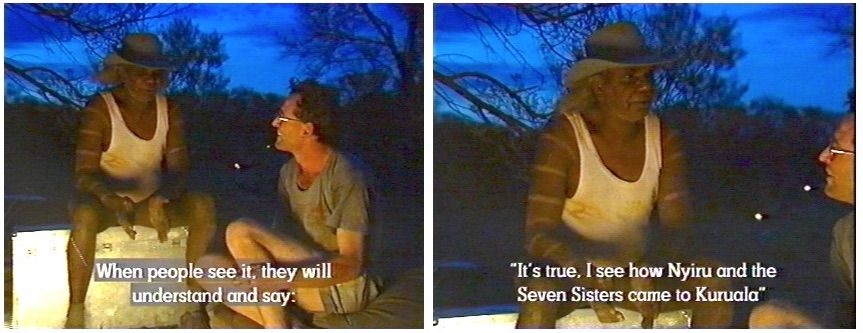
Noli Roberts in Satellite Dreaming
Traditional Aboriginal people talk about the process of recording their stories on video as one of deep validation. It is true. The ancestors, dreamtime creatures, are here. They are the hills, the rocks, the sandbanks. Noli Roberts, the custodian of the Seven Sisters' site at Kuruala explained why he wanted it videoed: 'When people see it they will say, "It's true. I see how Nyiru and the Seven Sisters came to Kuruala".' Eric Michaels - the American anthropologist who helped to set up Warlpiri Media in the 1980s - refers to the 'centrality of the prohibition against fiction for Warlpiri oral tradition'. In its conviction of absolute truth, its strict adherence to the law of the 'dreamtime' and the authority of its stories, Aboriginal culture represents the polar opposite of postmodern uncertainty. In our culture television is - thankfully - losing the ability to claim any such representative authority, as Reithian certainties recede; but we are also losing any sense of the social purpose, meaning or value of television in these new circumstances - a sense that these democratically controlled TV stations in the desert have in spades.
So I think that the real appeal to me of EVTV and Warlpiri Media has less to do with their particular function in representing indigenous cultures and communities than it has with the media/political example they hold up. They offer a model of a different, more purposeful and democratic relationship between TV and communities of all kinds – particularly those that feel undernourished by the dominance of centralised and increasingly global television systems.
During the writing of this piece I tried to find the Dukakis film. It turned out to have been released but seems to have sunk without trace. BBC1 screened it last June, and it was released on video for a while: but it has since - in the jargon of the video trade - been 'deleted'. I've managed to see it only because a colleague in the BBC found me a copy.
Simon's tape will be back on the shelves at EVTV – a contemporary tjukurrpa alongside the Seven Sisters and all the other dreamings. Maybe he puts it on occasionally, interrupting AUSSAT's transmission of ABC or the commercial station from Alice, so the community can re-live the joke of the enormous bonfire.
(Originally published in Soundings magazine, issue 5, Spring 1997)
